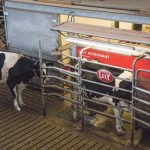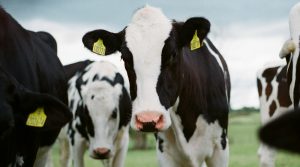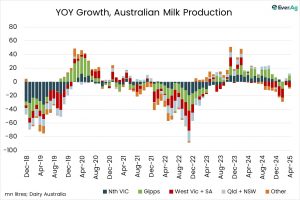
Slowing global milk production will eventually match the “tepid” growth in demand for dairy seen in most regions, preventing further declines in global dairy prices, Rabobank says in a new industry report.
In recent months, lower milk prices in most key global dairy-producing regions have begun to result in reduced supplies, according to the bank’s Q3 Global Dairy Quarterly.
“In our view, however, a possible whiplash effect is growing in probability,” said Lucas Fuess, US-based senior dairy analyst at Rabobank.
“We may see a demand resurgence emerging months before global milk output can recover,” he said.
For Australia, the report says, milk production turned positive in May, posting the first month-on-month growth since mid-2021.
Growth continued in June, increasing by 1.2 per cent, and bringing national production for the 2022-23 season to 8.129 billion litres, down five per cent year-on-year.
Rabobank expects milk supply to expand by two per cent in the 2023-24 season, supported by healthy on-farm profit margins and overall ample feed and irrigation water availability.
For Australian dairy producers, price signals are very positive against a weak global backdrop, the report says, although there are unlikely to be any higher price movements unless domestic and export market conditions improve significantly.
Australian dairy export volumes tumbled in 2022-23. For the season (up to May) total export volumes were down 15 per cent with large tonnage declines in skim milk powder (SMP), cheese and liquid milk.
However, Rabobank expects Australia’s exportable surplus to stabilise in 2023-24, due to a mild milk pool recovery and sluggish domestic demand growth.
Rabobank has lowered its overall 2023 global milk production forecast.
The report says milk production from the ‘Big 7’ export regions — New Zealand, Australia, the European Union, the United States, Uruguay, Brazil and Argentina — is now anticipated to grow by 0.3 per cent year-on-year in 2023.
This downgrade from last quarter’s estimate of 0.5 per cent is driven by production reductions in most key global regions, including the US, EU and New Zealand.
Into 2024, global dairy output is expected to climb by 0.4 per cent, far less than the 1.6 per cent annual average gain seen from 2010 to 2020.
Attention also remains laser-focused on both supply and demand in China, the report says, where the severity of economic headwinds and the duration of the lull in economic growth are reducing the likelihood of a strong demand recovery.
Leading dairy processors do report modest demand recovery but, to date, this has not been able to offset strong Chinese domestic milk production growth, Rabobank says.
The country’s milk production growth will slow into the second half of 2023 and into 2024, but a complete market rebalance is not expected in the near term and positive year-on-year imports are not anticipated until late 2024 or early 2025.























